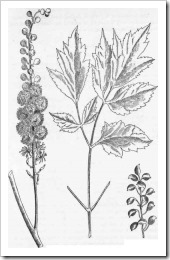Current study: Xi S, Liske E, Wang S, et al. Effect of isopropanolic Cimicifuga racemosa extract on uterine fibroids in comparison with tibolone among patients of a recent randomized, double blind, parallel-controlled study in Chinese women with menopausal symptoms.
An original menopause study, published in 2007[1] enrolled 244 Chinese women aged 40-60 years with menopause symptoms who were treated with either black cohosh extract, 40 mg/day (n=122) or tibolone 2.5 mg/day (n=122) for 3 months. The current study investigated the subset of women from that study (n=62) who had at least one uterine fibroid at the onset of the study, and compared the effect of black cohosh extract (n=34) on fibroid size compared with tibolone (n=28), using transvaginal ultrasound.
The patients were treated for 12 weeks with iCR (isopropanolic Cimicifuga Racemosa) or tibolone. Study visits were at entry, 4 weeks and 12 weeks. Clinical variables including the Kupperman Index (KI), vital signs, body weight, co-existing diseases, adverse events and co-existing medications were recorded. In addition to blood samples for follicle stimulating hormone (FSH), estrogen, standard hematology and biochemistry and urine samples, transvaginal ultrasound was also performed before onset of study and at the end of treatment.
In the black cohosh group, the median volume of the largest individual fibroid decreased from 1787 mm3 at visit one to 1086 mm3 after 12 weeks. The mean diameter of the largest fibroid per patient significantly decreased during the treatment with a decrease of the total myoma volume of – 30.3% on average observed in 24 of the women in the black cohosh group (70.1%) during the 12 weeks. In the tibolone group, the median volume of the largest individual fibroid changed from 1063 mm to 1096 mm after 12 weeks, actually slightly larger. No statistically significant difference was found for the mean diameter of the individual largest fibroid as well, from baseline to 12 weeks. There was a decrease in the myoma volume in 10 of the women in the tibolone group (35.7%), but on average, it increased by +4.7% in the tibolone group.
In summary, the key results were that the percentage of volume change in the black cohosh extract group (-30.3% decrease) was significantly superior to the tibolone group, a 4.7% increase and the percentage of mean diameter change in the herbal group was significantly superior to tibolone as well. Lastly, the superior response rate of black cohosh 70.1% vs. tibolone 35.7% was important.
Other questions about the effect of black cohosh on hormone sensitive tissues might be considered here as well. A 12 month study showed that after 12 months of treatment with black cohosh extract, no increase in the risk of malignant change of the breast or endometrium was observed.[2] In another study, black cohosh extract did not increase the risk of tumor recurrent in patients with early endometrial cancer after 24 months of treatment for menopausal symptoms and after surgery.[3] In another study, 6 months of treatment with black cohosh daily did not cause change in the mammographic density and breast cell proliferation.[4] And yet another found that isopropanolic black cohosh extract did not increase the risk of breast cancer recurrence. [5]
To my knowledge, the current clinical study analysis is the first of its kind evaluating the effect of iCR on uterine fibroids. I will add this to my eager approach to helping perimenopausal women in particular, decrease their fibroid growth. We now have two recent botanical studies of import for uterine fibroids, this one, and the green tea extract study I wrote in an earlier blog posting. [6]
References
[1] W. Bai, H.-H. Henneicke-von Zepelin, S. Wang, et al. Efficacy and tolerability of a medicinal product containing an isopropanolic Cimicifuga racemosa, aka black cohosh (iCR) extract was in Chinese women from five hospitals in China, with menopausal symptoms: a randomized, double blind, parallel-controlled study versus tibolone. Maturitas 2007;58(1):31-41)
[2] Geller S, Shulman L, van Breemen R, et al. Safety and efficacy of black cohosh and red clover for the management of vasomotor symptoms: a randomized controlled trial. Menopause 2009;16(6):1156-1166.
[3] Li W, Sun N, Chen X, et al. Cimicifuga racemosa for the treatment of menopausal symptoms in patients with eaerly endometrial cancer after operation. Academic Journal of Second Military Medical University 2012;33(5):562-564.
[4] Hirschberg A, Edlund M, Svane G, et al. An isopropanolic extract of black cohosh does not increase mammographic breast density or breast cell proliferation in postmenopausal women. Menopause 2007;14(1):89-96.
[5] Henneicke-von Zepelin H, Meden H, Kostev K, et al. Isopropanolic black cohosh extract and recurrence-free survival after breast cancer. International J of Clinical Pharmacology and Therapeutics 2007;45(3):143-154.
[6] Roshdy E, Rajaratnam V, Maitra S, et al. Treatment of symptomatic uterine fibroids with green tea extract: a pilot randomized controlled clinical study. Int J Womens Health. 2013;5:477-486.
Photo credit: http://chestofbooks.com/flora-plants/flowers/Wild/Black-Cohosh-Bugbane-Black-Snakeroot-Cimicifuga-Racemosa-Crowfoot-Family.html#.U6tOFLFhsTA


